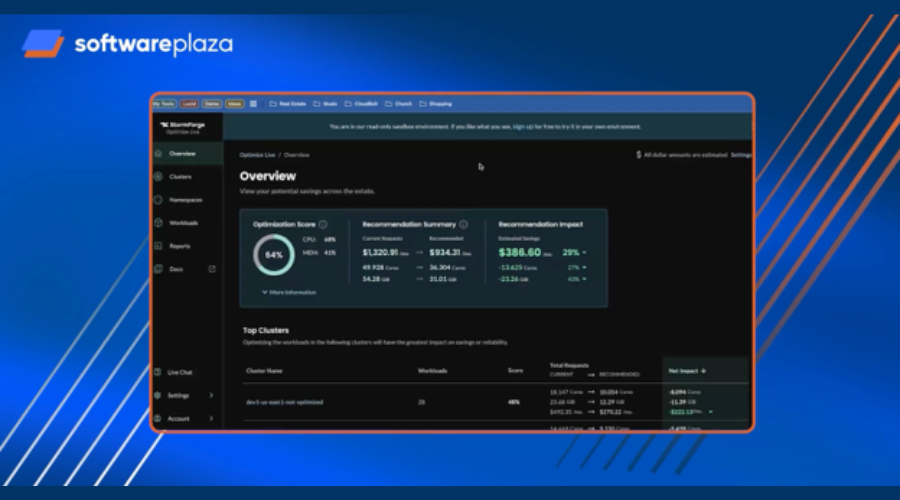Are your days filled with reviewing dashboards? Every team reporting to FinOps leaders has its own approach to presenting data. But what is happening is that there is a lot of visibility without much focus on results. This phenomenon of having to peruse too many data points is what CloudBolt calls the “report factory”: a loop of cost reports, unread recommendations, and Jira tickets that rarely translate into real savings.
When cloud costs are soaring and optimization remains elusive, CloudBolt is offering an orchestration-first approach that closes the loop from insight to action.
In this blog, we’ll break down what the “report factory” is, why it’s no longer sufficient for modern FinOps, and how CloudBolt, now supercharged by the StormForge acquisition, is helping companies achieve continuous optimization, especially for Kubernetes environments.
What is “report factory” in FinOps?
The “report factory” refers to a stagnant phase in cloud financial management where optimization tools generate mountains of insights but leave the actual execution to overburdened engineering teams. These tools:
- Identify overprovisioned resources or cost anomalies
- Generate cost-saving recommendations
- Export the data into Excel sheets or create Jira tickets
This approach creates insight without action. The recommendations often go untouched, not because they aren’t valid, but because applying them manually at scale is too complex, time-consuming, and risky. As a result, organizations continue to incur millions in unnecessary cloud spending while allocating even more resources to managing reports.
Why the “report factory” fails in practice
One of the primary reasons these report factory fail is due to human bottlenecks. Engineering teams already stretched thin are expected to review, validate, and implement cost recommendations manually, often long after the problem has occurred. The time between creating these reports and implementing insights can stretch to weeks or even months. In the meantime, costs continue to accumulate.
These reports also lack contextual intelligence and do not consider real-time performance dynamics or business-critical workloads. Created using traditional tools, they also have Kubernetes blind spots, thus affecting the dependability of these reports.
This results in decision paralysis, shadow IT, and ballooning costs, especially for organizations spending $10 million or more annually on cloud.
From insight to action: CloudBolt’s orchestration-first philosophy
CloudBolt challenges the status quo by closing the loop between recommendations and remediation through automation. At the heart of this approach is the idea that FinOps cannot succeed without orchestration.
Rather than merely surfacing cost-saving opportunities, CloudBolt allows users to:
- Define orchestration policies for remediation actions
- Automatically deploy changes via GitOps, CI/CD pipelines, or CloudBolt’s native auto-applier
- Continuously monitor utilization and adjust in real-time
This insight-to-action loop ensures that optimization is ongoing and scalable, not dependent on human intervention.
The game changer: StormForge + CloudBolt
CloudBolt’s orchestration platform was already poised to solve the “report factory” problem. However, the acquisition of StormForge has significantly enhanced this vision, particularly in the Kubernetes space.
StormForge brought with it:
- Real-time, AI/ML-powered Kubernetes optimization
- Continuous observation and performance learning
- A built-in “applier” that implements recommended changes autonomously
- Java heap sizing intelligence, pod affinity, and HPA integration
By integrating StormForge into CloudBolt’s broader FinOps and orchestration engine, the platform now offers closed-loop optimization for Kubernetes at scale, without requiring engineering teams to change their workflows.
Breaking the stigma: overcoming resistance to change
CloudBolt recognizes that many engineering leaders are hesitant to admit high levels of cloud waste. After all, no one wants to tell their CFO they’ve been overpaying by millions. However, Campos stresses that the goal is not to assign blame, it’s to provide teams with better tools to meet evolving goals. Engineering teams are not inefficient by nature, they’re focused on product velocity and uptime. Cost efficiency was not a primary goal until now.
CloudBolt makes it easier to expand the definition of “optimal” to include not just performance, but cost-efficiency, without rewriting existing workflows or slowing down innovation.
Flexibility meets control: customization at every step
One of CloudBolt’s core strengths is its flexibility. You don’t have to choose between control and automation rather, you will get both. Key features include:
- Optimization Goals: Bias towards cost savings, reliability, or a balance
- Guardrails and Thresholds: Set safe limits for CPU/memory changes
- Namespace-Level Policies: Treat prod workloads differently from R&D
- Java-Specific Optimizations: Fine-tuned recommendations for heap settings
CloudBolt’s orchestration platform supports everything from full automation to manual deployment approval, giving FinOps, platform, and engineering teams the confidence to act without fear.
Try it for yourself: quick start, no commitment
Getting started is easy in three simple steps:
Step 1 - Install CloudBolt StormForge and receive real-time recommendations with a free trial.
Step 2 - Opt for the Pay-As-You-Go option available on AWS Marketplace for EKS workloads.
Step 3 - Finally, integrate with existing GitOps, CI/CD, and HPA setups.
Within hours, teams can see where the waste is, quantify potential savings, and take steps toward full automation.
Conclusion: FinOps that works while you sleep
Based on what we have learned thus far, CloudBolt has successfully ended the era of the report factory.
In its place, CloudBolt offers a dynamic, responsive, and intelligent FinOps platform that not only highlights inefficiencies but also automatically fixes them. By combining real-time insights with orchestrated actions and turbocharging it with StormForge’s AI for Kubernetes, CloudBolt is helping organizations reduce costs, decrease engineering toil, and enhance reliability.
This isn’t just cost optimization, it’s autonomous infrastructure management that works while you sleep.
This blog is based on a webinar titled “CloudBolt x StormForge: Why Automated FinOps Beats Human Effort” with Kyle Campos, CTO of CloudBolt. To watch the full episode, click here.






